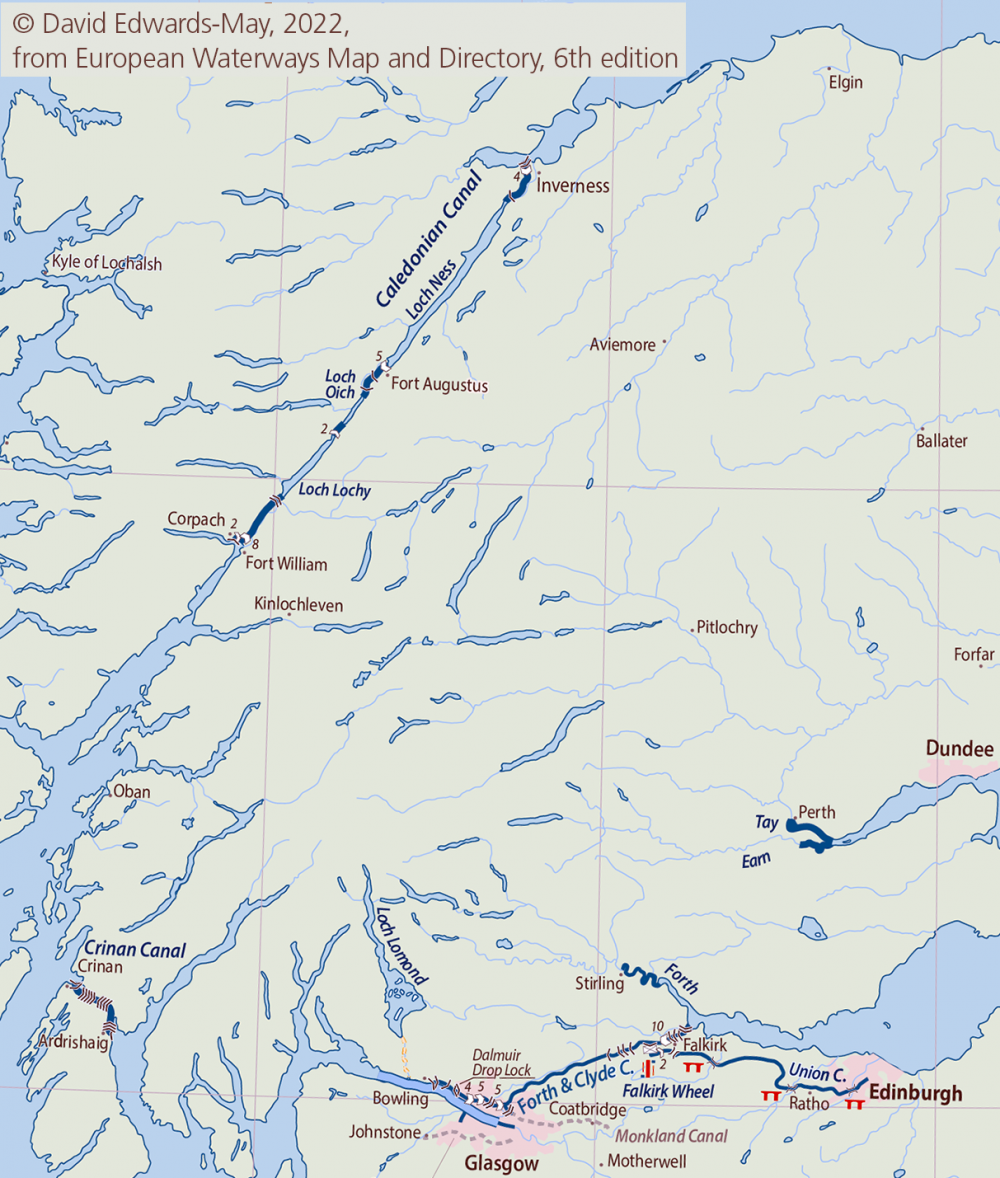Scottish canals map (click to open)
Caledonian Canal
- Boat length : 150’ or 45.72m
- Boat width : 35’ or 10.7m
James Watt first surveyed the route for this major navigational enterprise in 1773, searching for a safe means for the British Navy to avoid going through the perilous Pentland Firth and around Cape Wrath. It took thirty years before the renowned engineer Thomas Telford was commissioned to start work on the project and allocated a budget of £474,000. Twelve years later the canal, complete with 29 locks, opened at a hugely inflated cost of £910,000. There were teething problems in the 1840s because in spite of the enormous costs, substandard materials had been used. Some argue that the Caledonian’s finest hour was during World War One when it enabled British ships to avoid the lethal German patrols off the coast of northern Scotland. This much loved waterway has undergone a number of renovations during the last century. Hydraulic locks were installed in the 1960s and another large programme of restoration was undertaken between 1995 and 2005. An enduringly popular way to cross from sea to shining sea, the Caledonian remains a major attraction in its own right and is used by both commercial and leisure craft.
How to choose things you might like to do! Top of the list must surely be a visit to Loch Ness where you can search for the monster to your heart’s content (and at the same time enjoy the sublime beauty of the ruins of Urquhart castle, which jut out into the water and are romantic enough to take your breath away). If you want to burn off the calories from some of the delicious teas available at every turn, you might like to try a cycling tour of Inverness – it’s a great way to explore the capital of the Highlands, and for history lovers a trip to the battlefield at Culloden and its excellent visitor centre will certainly stir the pulse.
Forth and Clyde Canal
- Boat length : 68’7” or 20.9m
- Boat width : 19’6” or 6.02m
- Draft : 6’ or 1.84m
- Headroom : 9’ or 2.74m
Parliamentary consent for the building of the Forth and Clyde canal to link Scotland’s premier cities and their respective estuaries was given in 1768 and work was begun at what would come to be known as Grangemouth. Costs were high and seven years later the excavations were obliged to stop just north of Glasgow for lack of funds, and although local merchants were able to raise some of the cash needed to maintain progress, the real rescue came in 1785 when the government began to receive revenue from estates that were forfeited after the failure of the Jacobite rebellion, which meant that the work could be completed in 1790. The result was a navigation 35 miles long containing 39 locks. Initially successful, the canal began to struggle as sea vessels grew in size and could no longer pass through it. The Forth and Clyde was bought in 1867 by the nemesis of the waterways network – a railway company, and it was officially closed down almost a hundred years later in 1962. All was not lost! One of the largest grants made to mark the passing of the Millennium was a £83.5 million investment in an ambitious project to reopen the canal and once again link Edinburgh and Glasgow by means of water. In 2002 the Falkirk wheel was constructed as part of the same endeavour and now connects the Forth and Clyde to the Union canal for the first time in seventy years.
The Falkirk Wheel is an absolute must-see! It’s an astonishing feat of engineering, replacing the old lock flight with a rotating boat lift that has more than fulfilled its brief to be an iconic landmark. It raises boats by 24 metres to connect them to an aqueduct and two further locks, in order to gain entry to the Union canal. Here’s a fascinating fact: the component parts were constructed and assembled in Derbyshire, then dismantled and transported to Falkirk by 35 lorries before being reassembled and winched into place. Seeing it operate is like watching poetry in motion.
Edinburgh and Glasgow Union Canal
- Boat length : 72’ or 21.95m
- Boat width : 12’ or 3.6m
- Draft : 3’ or 0.9m
- Headroom : 9’ or 2.7m
The Edinburgh and Glasgow Union canal, sometimes known simply as the Union, was first planned in 1793 as a means of moving coal from central Scotland to Edinburgh and the West. The scope was widened in 1813 when a decision was taken to link it to the Forth and Clyde canal. The scheme received parliamentary approval in 1817 and the canal was built in an impressive four years, opening in 1827. The expansion of the railways had an effect on the levels of traffic and in 1849 the canal was sold to its arch rival the Edinburgh and Glasgow Railway Company. The decline continued in spite of this and in 1921 the eastern terminus was closed, with the western terminus following in 1933 as commercial traffic ceased altogether. The Union was officially shut to navigation in 1965 but the development of the leisure boating industry changed everything. At the turn of the century £83.5 million was granted to fund the construction of the Millenium Link, an ambitious project to restore the canal and link it to the Forth and Clyde by means of the stunning Falkirk Wheel.
There’s more poetry, also in steel, close to the Falkirk Wheel : the Scottish Kelpies. These magnificent beasts tower 30 metres high and are intended to be a monument to horse-powered heritage in Scotland, taking the shape of two horses’ heads representing kelpies, or water spirits. They were designed by inspirational sculpture Andy Scott and, unveiled in April 2014, they are a sight to behold.
British-Irish waterway regions – Northern | East Midlands | West Midlands | Welsh | Southern | Scottish | Irish
French waterway regions – North | North-East | North-Central | West | Centre | South-East | South | South-West

